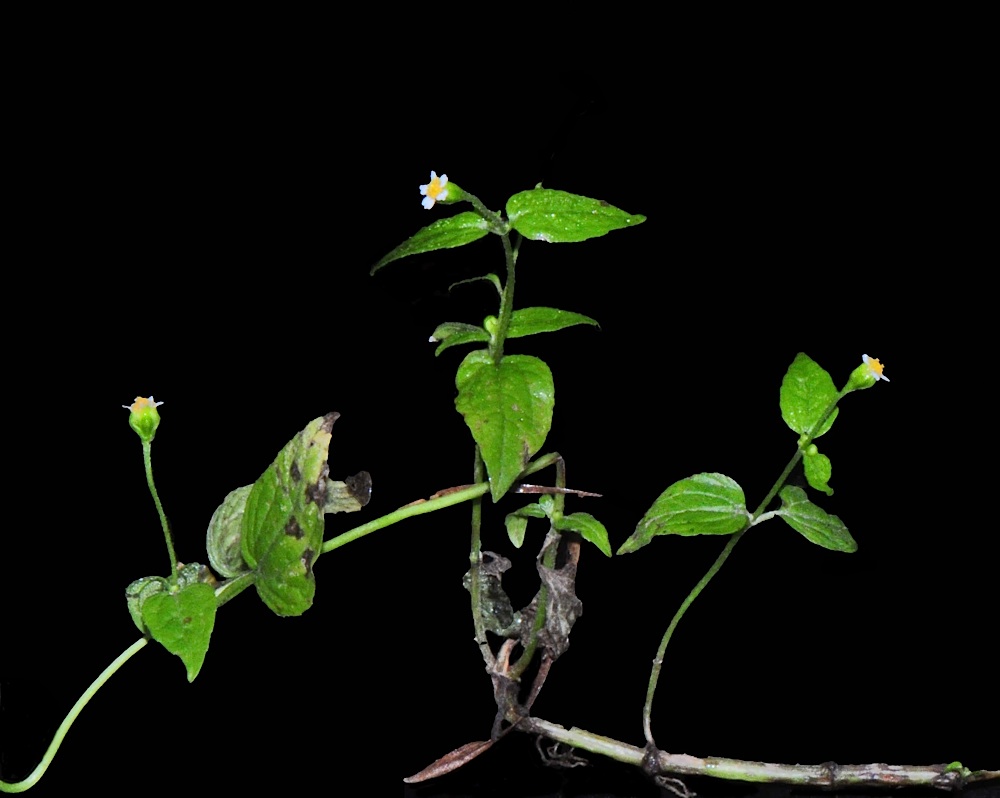Galinsoga
|
Family: Asteraceae |
Annuals, 2-62 cm. Stems erect. Leaves cauline; opposite; petiolate; blades (3-nerved) lanceolate to broadly ovate, margins entire or serrulate to serrate, faces glabrate to densely pilose. Heads radiate or discoid, in ± cymiform arrays. Involucres hemispheric to campanulate, 2.5-6 mm diam. Phyllaries persistent or falling, 6-9[-16] in 2[-3] series (elliptic, lance-ovate, oblong, or ovate, outer shorter, herbaceous or scarious, margins entire or minutely laciniate). Receptacles conic, paleate (paleae persistent or falling, scarious, proximal broadly elliptic to obovate, often connate at bases or nearly to apices, united in groups of 2-3 to adjacent proximal phyllary, each complex often enclosing and shed with a ray cypsela; distal persistent or falling, lanceolate to obovate, entire or 2- or 3-lobed, convex to conduplicate). Ray florets [0-](3-)5(-8)[-15], pistillate, fertile; corollas white or dull white to pinkish [purplish] (tubes pilose, laminae quadrate-obovate to oblong, lobes 0-3). Disc florets 5-50[-150], bisexual, fertile; corollas yellow, tubes (pilose) shorter than cylindric throats, lobes 5, deltate (anthers yellow; style-branch apices acute). Cypselae obconic to obpyramidal, glabrous or strigose (rays often shed with subtending phyllary plus 2-3 adjacent paleae); pappi 0, or persistent, of 5-20, white or gray, fimbriate, sometimes aristate scales. x = 8. Galinsoga is closely related to Sabazia Cassini of Mexico and South America and to at least some members of Alloispermum Willdenow, primarily from South America. Galinsoga might best be treated as a single larger genus including Alloispermum and Sabazia (J. M. Canne 1978; J. L. Panero et al. 1999).
Heads small, radiate, the rays few, short, broad, only slightly surpassing the disk, white (pink), pistillate and fertile; invol bracts few, relatively broad, greenish at least in part, several-nerved, each subtending a ray, and sometimes joined at base with the 2 adjacent receptacular bracts; a few shorter and narrower outer bracts often present; receptacle conic, chaffy, its bracts membranous, rather narrow, nearly flat; disk- fls perfect; style-branches flattened, with short, minutely hairy appendage; achenes 4-angled, scarcely compressed, or, especially the outer, somewhat flattened parallel to the invol bracts; pappus of several or many scales, often fimbriate or awn-tipped, that of the rays ±reduced or none; annuals with opposite lvs. 14, originally New World. Gleason, Henry A. & Cronquist, Arthur J. 1991. Manual of vascular plants of northeastern United States and adjacent Canada. lxxv + 910 pp. ©The New York Botanical Garden. All rights reserved. Used by permission. |

